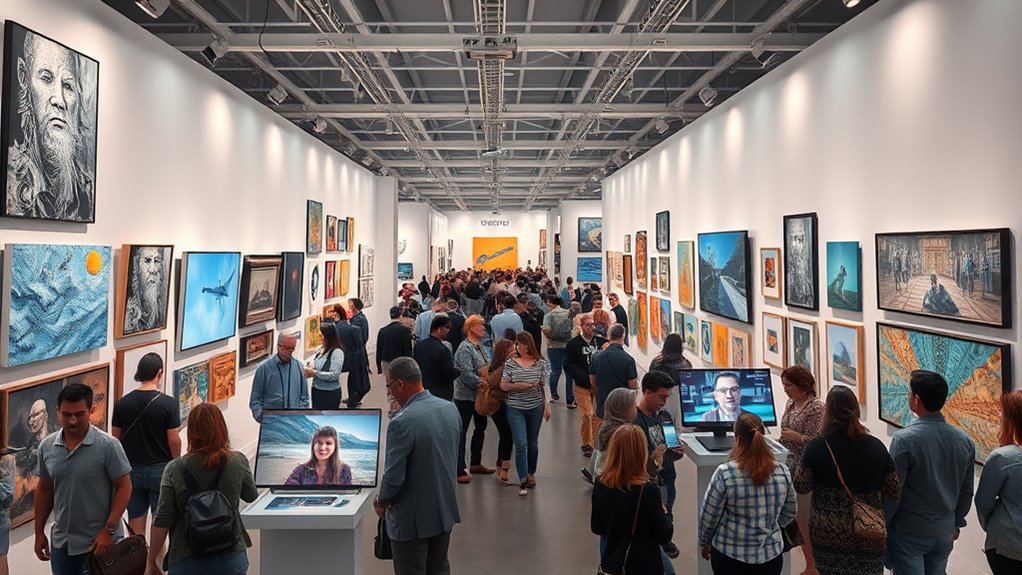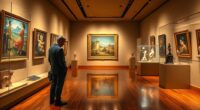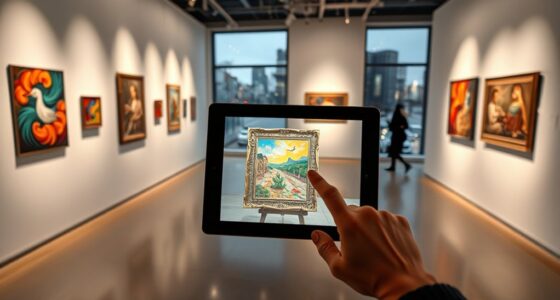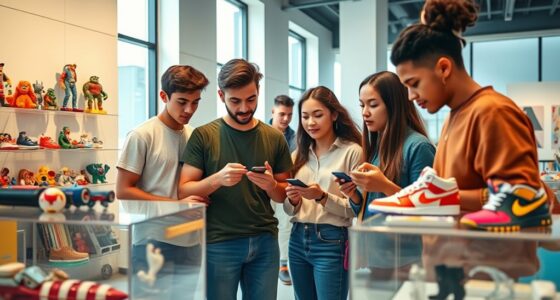The art world is evolving thanks to hybrid models and digital participation, making exhibitions more accessible, interactive, and inclusive. You can now explore virtual galleries from home, enjoy high-resolution images, and engage with artworks through online features that mimic in-person visits. Digital components like live-streamed events and virtual tours expand reach beyond physical venues. To discover how these innovations continue shaping the future of art fairs, keep exploring the latest developments and trends.
Key Takeaways
- Hybrid models combine in-person and digital experiences, expanding accessibility and audience reach for art fairs.
- Virtual galleries enable remote viewing, interactive features, and ongoing engagement beyond physical event dates.
- Integration of online components like live streams and virtual walkthroughs enhances participation for global audiences.
- Technological advances, such as high-resolution images and immersive tools, improve online art authenticity and interaction.
- Continuous digital engagement fosters lasting relationships with collectors, galleries, and artists, shaping the future of art fairs.

Art fairs have transformed considerably over the years, adapting to changing technologies, audience preferences, and industry trends. Today, the rise of virtual galleries plays a significant role in this evolution, offering new ways for both artists and collectors to connect beyond physical spaces. Virtual galleries allow you to browse collections from your own home, eliminating geographic barriers and making art more accessible than ever. This digital shift enhances collector engagement by providing immersive experiences, detailed high-resolution images, and even interactive features that mimic the feeling of being in a gallery. As a result, you can explore artworks at your own pace, ask questions in real-time, and get tailored recommendations, all through a simple online platform. These innovations make it easier for you to discover new artists and make informed purchasing decisions, which boosts the overall vibrancy of the art market.
The integration of virtual galleries into traditional art fairs has also led to hybrid models that blend physical presence with digital participation. You might attend a fair in person, enjoying the tactile experience of viewing artworks firsthand, while simultaneously engaging with digital components like live-streamed exhibitions, online bidder registrations, or virtual walkthroughs. This hybrid approach expands the reach of art fairs, allowing you to participate regardless of your location or mobility constraints. It also offers a more flexible and inclusive experience, giving you access to a broader range of artworks and events that would otherwise be out of reach. Whether you’re a seasoned collector or a casual enthusiast, these models enable you to stay engaged with the art community in ways that suit your schedule and preferences.
Furthermore, digital participation encourages ongoing engagement beyond the duration of the event itself. You can revisit virtual galleries, follow up on artworks of interest, and stay connected with galleries and artists through online platforms. This continuous access fosters a deeper relationship with the art world, encouraging you to explore new genres, invest in emerging talents, or simply enjoy art in a more personalized manner. As technology continues to evolve, the lines between physical and digital experiences will blur even further, providing richer, more interactive ways for you to engage with art. Additionally, the use of high-resolution images and color accuracy in virtual displays enhances the authenticity and appreciation of artworks online. Ultimately, the integration of virtual galleries and hybrid models not only broadens access but also enriches your overall experience, making art fairs more dynamic, inclusive, and responsive to your needs as a collector or enthusiast.
Frequently Asked Questions
How Do Hybrid Art Fairs Impact Local Art Communities?
Hybrid art fairs positively impact your local art community by expanding community outreach and supporting local artists. You can attend both physical and virtual events, increasing exposure for local talent and fostering greater engagement. These models make it easier for local artists to showcase their work to wider audiences, strengthening community ties and encouraging growth. As a result, your local art scene becomes more vibrant, connected, and resilient in today’s evolving art landscape.
What Are the Costs Associated With Digital Participation for Artists?
You face costs with digital participation, including investing in digital infrastructure and online marketing. You must upgrade equipment, guarantee reliable internet, and develop digital content, all of which require time and money. These investments can be substantial, especially for emerging artists. You also need to allocate resources for online promotion, reaching wider audiences but increasing your expenses. Balancing these costs is essential for successful digital engagement and sustainable participation.
How Is Audience Engagement Measured in Virtual Art Fairs?
You measure audience engagement in virtual art fairs through digital metrics like website visits, time spent viewing artworks, and interaction rates on live chats or comment sections. Virtual engagement can also be gauged by tracking social media activity, shares, and attendance at online events. These digital metrics help you understand how viewers connect with the art and the fair, providing insights to enhance future virtual experiences and boost overall participation.
What Technological Challenges Do Organizers Face in Hybrid Models?
Like steering a digital jungle, organizers face challenges with digital infrastructure and cybersecurity threats in hybrid art fairs. You must ensure seamless streaming, stable Wi-Fi, and reliable platforms, all while warding off hackers and data breaches. Balancing immersive physical experiences with robust online security tests your technical agility, demanding constant updates and vigilant monitoring. Without these, the virtual experience risks collapsing, leaving audiences lost in the digital wilderness.
How Do Online Platforms Ensure the Authenticity of Digital Art?
Online platforms guarantee the authenticity of digital art by using digital watermarking and blockchain verification. Digital watermarking embeds unique identifiers into the artwork, making it hard to duplicate or forge. Blockchain verification records the provenance and ownership history securely, allowing you to trace the artwork’s origin and authenticity easily. Together, these technologies give you confidence that the digital art you’re viewing or purchasing is genuine and verifiable.
Conclusion
As you explore the future of art fairs, it’s clear hybrid models are transforming the scene—over 70% of fairs now incorporate digital components, expanding reach and accessibility. By blending physical and virtual experiences, you can enjoy exhibitions from anywhere, connecting with a global audience. This shift isn’t just trend-driven; it’s reshaping how you engage with art. Embrace these innovations, and you’ll find new opportunities to experience and support artists in exciting, unprecedented ways.









